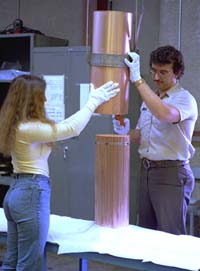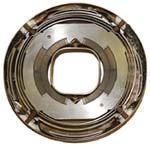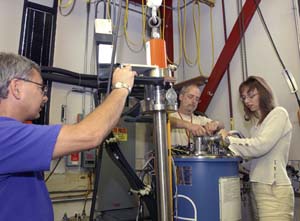|
Superconducting Magnets
From Wilson's vision to a hospital near you
by Matt Hutson
When you cool a piece of metal below a critical temperature, something magical happens. The atoms begin passing along electrons with zero resistance. People in the know refer to this rare state as "superconductivity."
 | | To produce superconducting wire, technicians bundle 2,100 niobium-titanium alloy filaments into a single billet, which gets rolled and stretched into a thin wire. The photo in the background shows an enlargement of wires in a superconducting cable. - Fermilab Photo |
When Robert Wilson set out to build the world's most powerful particle accelerator, he envisioned using superconducting magnets for guiding and focusing the beam of protons. Despite the superior power and efficiency of these magnets, no one had any idea how to build a whole accelerator out
of them. But Wilson left room in the tunnel under the normal-conducting magnets of the Main Ring for a future upgrade, and as soon as the Main Ring began operating in 1972 he launched a superconductor R&D program.
The new ring didn't earn the name Tevatron until after construction, as it approached one trillion electron volts (1 TeV) per beam. Originally it went by two names: the Energy Doubler and the Energy Saver. The new accelerator would produce twice the beam energy of the old one, and because the magnets lacked electrical resistance they wouldn't need a constant source of current to stay magnetized. Despite the need for cooling, Fermilab's electrical bill would decrease by a predicted $5 million a year.
The idea of constructing a superconducting cyclotron gathered many critics. The plan required 774 dipole magnets (for steering the beam) and 216 quadrupole magnets (for focusing), plus a stable of spares, each about 20 feet long. Alvin Tollestrup, a key player in the magnet development, recalls giving a talk on the subject at CERN, where he encountered "a big room with these guys sitting up there laughing... they thought we were nuts."
 | | Dipole magnet cross section |
Production of superconducting cable presented the first big challenge. Each magnet has either two or four full-length coils of Rutherford cable. Each cable has 23 strands of wire twisted together. And each strand, only 27 thousandths of an inch in diameter, has 2100 niobium-titanium alloy filaments running through a matrix of copper. Finding the right materials, the right heat treatments, the right configuration of elements, and the right cabling method proved significant hurdles. And Fermilab needed the stuff in bulk. (Bulk as in about a quarter of a trillion feet of filament.)
Running current through the coil would produce more than a ton of outward force per linear
inch. But to prevent friction and avoid losing superconductivity, the coils needed to remain motionless. The solution: epoxy-covered steel collars, custom-made to an accuracy of .001 inch, bound around the coils with a huge hydraulic press. Engineering won out.
"Every program in superconductivity that there is today owes itself in some measure to the fact that Fermilab built the Tevatron and it worked."
— Robert Marsh, former CEO of Oregon-based Teledyne Wah Chang, world's largest supplier of superconducting alloys. |
The lab's success may rest on one of Wilson's most innovative ideas: the magnet factory. Other labs concentrated all their efforts on building one good magnet. Some magnet builders succeeded but couldn't reproduce their success with a second magnet. Wilson's teams built dozens of miniature test magnets, each only one or five feet long. The lab could build, test, and redesign these mini-magnets in only a few weeks. The idea was to keep churning out test magnets until one worked. When successful, the lab had two things: a good magnet, and an assembly line for producing good magnets.
Success with the Doubler laid the groundwork for future accelerators around the world. Two scientists from DESY who came to help with the Tevatron's magnets took their experience back with them to work on HERA, the hadron-electron ring accelerator in Hamburg, Germany. The ill-fated Superconducting Super Collider in Texas also would have used magnets designed and built at Fermilab. In 1994, Fermilab began R&D for the construction of CERN's Large Hadron Collider (LHC). The lab will produce nine of the collider's 18 six-ton quadrupole magnets, and put all 18 into cryostats. Along with new people and equipment, the lab has marshaled the facilities, tooling, and experience gained from the Tevatron and the SSC to forge this new effort.
 | | Superconductor R&D scientist Emanuela Barzi (right) with lab technicians Tom Wokas (left) and Tom Van Raes testing niobium-tin samples in a cryostat. - Photo by Fred Ullrich |
Although commissioning of the LHC remains four years away, Fermilab's Technical Division has
been working since 1998 on a research program to produce accelerator-quality magnets capable of at least 11 Tesla. (For comparison, the Main Ring was 1.8T, the Tevatron is 4.2T, and the LHC will
be 8.4T.) The High Field Magnet Program (HFM) includes a team led by Emanuela Barzi exploring new superconducting materials. The new strands—a mixture of copper, niobium, and tin—can produce fields as high as 16T. The ongoing R&D now guides the LHC Accelerator Research Program (LARP), aimed at more powerful magnets set to replace those in the LHC 12 years from now.
Pushing the limits of material science has benefited more than particle physics. The Tevatron paved the way for today's largest superconductor application: magnetic resonance imaging (MRI). Engineers calculated that Fermilab at one point had purchased 95% of the niobium-titanium the world had ever produced. Robert Marsh, the head of a major alloy supplier, once said that "every program in superconductivity that there is today owes itself in some measure to the fact that Fermilab built
the Tevatron and it worked." The market for superconductors currently stands around $3.5 billion a year. As ever, Wilson was on the frontier of something big.
On the Web:
Tevatron Magnets:
www-bd.fnal.gov/public/tevatron.html
LHC Magnets:
www-td.fnal.gov/projects/lhc.html
Accelerators Science in Medicine:
www.fnal.gov/pub/pulse/

|



